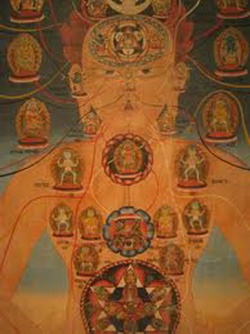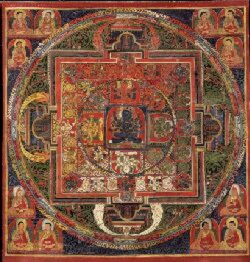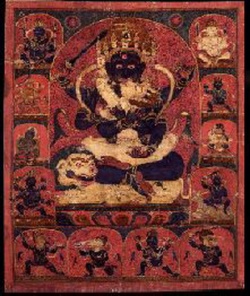Anuttarayoga Tantra
Anuttarayoga Tantra (Sanskrit, Tibetan: bla na med pa'i rgyud), often translated as Unexcelled Yoga Tantra or Highest Yoga Tantra, is a term used in Tibetan Buddhism in the categorization of esoteric tantric Indian Buddhist texts that constitute part of the Kangyur, or the 'translated words of The Buddha' in the Tibetan Buddhist canon.
AnutaraYoga Tantra: This group of texts was never brought to Japan and practiced, although a few seem to be included in the Tripitaka, they are not practiced.
These tantras are practiced in Tibetan Buddhism and Newar Buddhism.
Some of the major texts are the Guhysamaja Tantra, the Kalachakra Tantra, the Chakrasamvara Tantra, and the Hevajra Tantra.
There are numerous texts and practices in the Highest Yoga Tantra category, but since my page is focused on Japanese Buddhism,
In the New Schools of Tibetan Buddhism, Anuttarayoga Tantra is the highest of four classes and is associated with the Mahamudra route to Enlightenment.
According to the Gelugpa tradition, in Highest Yoga Tantra,
The Buddha taught the most profound instructions for transforming sensual pleasure into the quick path to Enlightenment, which in turn depends upon the ability to gather and dissolve the inner winds (Sanskrit: prana) into the central channel through the Power of Meditation.
In the classification of the Dzogchen system, used by the Nyingma, it is considered equivalent to the Mahayoga tantras.
The Dalai Lama XIV states: "old translation Dzogchen and new translation anuttarayoga tantra offer equivalent paths that can bring the practitioner to the same resultant state of Buddhahood".
The practice of Anuttarayoga Tantra in the Vajrayana tradition of Buddhism is characterized by the requirement of Empowerment from a qualified Guru, usually a Lama, use of ritual techniques, and the practice of various meditative and subtle Body yogas, to effect personal transformation and to attain Enlightenment through the realization of the Mindstream as a Meditational Deity, or a Yidam.
According to Miranda Shaw, Anuttarayoga Tantra texts "have remained at the forefront of contemplation, ritual, and interpretation throughout the Himalayan Buddhist sphere"
Translation terminology
Anuttarayoga Tantra literally means 'Unexcelled Union Continuity'.
While the term is frequently translated as 'Highest Yoga Tantra' in English writings, this is not quite accurate.
The Tibetan term bla med (back translated to Sanskrit as anuttara) is a negation of a comparative—not or none (med/an-) higher (bla /uttara)—rather than a superlative.
Had the authors of this term intended to indicate directly "highest," superlatives were readily available: e.g. mchog ("supreme" or Sanskrit uttama, "highest").
Rather, they chose consistently to use a comparative rather than a superlative.
Similarly, the terms used in Sanskrit also uniformly utilize comparatives: yogottara ("higher than yoga") and niruttara (also a negation of the comparative).
English usage, and European usage in general, has largely overlooked this nuance.
As scholar Isabelle Onians explains: "Yoginitantras are in the secondary literature often called Anuttarayoga.
But this is based on a mistaken back translation of the Tibetan translation (rnal byor bla med kyi rgyud) of what appears in Sanskrit texts only as Yogānuttara or Yoganiruttara (cf. SANDERSON 1994: 97-98, fn.1)."
Anuttarayoga in Tibetan classification
The term appears in the 'Five Groups of Dharma', according to Pabongka Rinpoche.
They comprise:
Dharma of the Shravakas
Dharma of the Pratyekabuddhas
the Sutra Mahayana Dharma
the Outer Tantras - the Kriya, Charya and Yoga Tantras, Anuttarayoga Tantra
In the Nyingma school of Tibetan Buddhism, Anuttarayoga tantra is sometimes used as a synonym for the Mahāyoga tantra of their nine-yāna formulation, wherein six levels are articulated in two triads, the 'Outer' and 'Inner tantras.
The Outer Tantras
Kriyā,
Caryā, and
Yoga tantra.
The Inner Tantras are
In the New Schools of Tibetan Buddhism, the four categories of tantras are;
A further sub-classification is sometimes made among Anuttarayoga tantras into '
Father',
'Mother', and
although this latter category is the subject of some controversy.
Varieties of Anuttarayoga Tantras
Five collections of Anuttarayoga tantras became prominent in Tibet initially
Guhyasamāja or 'Esoteric Community'
Yamāntaka or 'Death Conqueror' (alternatively known as Vajrabhairava or 'Vajra Terrifier')
Hevajra or 'O, Vajra!', Mahāmāyā or 'Great Play of Illusion'
Cakrasaṃvara or 'Wheel of Great Bliss'
The Kālacakra or 'Wheel of Time' tantra, was disseminated slightly later.
To date, the term 'Anuttarayoga Tantra' has not been discovered in Indian sources, wherein the categories used are Mahāyoga, and Yogottara , Yoganiruttara, or Yoginī-tantras for what the Tibetans consider "Father" (pha rgyud) and "Mother Tantras (ma rgyud).
Father Tantras
The mahāyoga-tantras of Pala Empire India became known in Tibet as 'Father Tantras' (pha rgyud).
According to the Gelug view, following Tsongkhapa's reasoning, Father Tantras emphasize the creation of a Buddha Form through the cultivation of an illusory Body, on the basis of practices with the energy system of the subtle Body.
Earlier Sakya masters and Kagyu scholars had viewed Father Tantras as emphasising the practice of blissful awareness.
Father Tantras have also been seen as emphasizing the use of Anger (Pratigha) as the path of practice, focusing on the 'Emptiness' aspect of Buddha nature.
The post-Tsongkhapa Sakya scholar Tagtsang Lotsawa identified Father Tantras as those that emphasise the secret, or hidden, Empowerment of the four empowerments of Anuttarayoga Tantra.
The secret Empowerment; plants, seeds for achieving an illusory Body.
Among the Father Tantras are Guhyasamāja and Yamāntaka.
Mother Tantras
The yoginī-tantras which became known in Tibet as 'Mother Tantras' (ma rgyud) emphasize the development of enlightened awareness (the "mind of the illusory Body) through the cultivation of the fundamental pure mind of all beings, known as 'brilliance' (prabhāsvara) (frequently translated, following the Tibetan, as 'clear Light').
They focus on devotion as the foundation of tantric practice.
They are also considered to emphasize the utilization of desire (tṛṣṇā) as the path of practice, focusing on the brilliant (prabhāsvara) aspect of Buddha nature.
Among the Mother Tantras, the most prominent is the Cakrasaṃvara.
The practice of Vajrayogini evolved out of the Cakrasaṃvara and is now a de facto practice in its own right.
Other Mother Tantras are Hevajra and Caṇḍamahāroṣaṇa.
Non-dual Tantras=
Non-dual tantras utilize both Anger and desire as an antidote to Delusion (avidyā), focusing on both the physical and mental, void and brilliant, aspects of enlightened mind.
The example typically advanced for this category is the Kālacakra.
The Sakya tradition also considers Hevajra to be a non-dual tantra but other traditions classify it as a yoginī-tantra.
In Practice
In the Deity Yoga practices of Anuttarayoga Tantra, two stages are practiced:
the Generation Stage
and the Completion stage.
In some tantras both stages can be practiced concurrently, in others 'Generation Stage' must be perfected before starting to practice 'Completion stage'.
Kagyupa
Schaeffer (1995: p. 16) holds that the Zabmo Nangdon (Tibetan: ཟབ་མོ་ནང་དོན, Wylie: zab mo nang don) is a major work of 'Rangjung Dorje' (Tibetan: རང་འབྱུང་རྡོ་རྗེ, Wylie: rang 'byung rdo rje) (1284–1339), the third Karmapa, born to a Nyingma family he received the full transmission of The Nyingma Tradition, in addition to the Karma Kagyu.
This text forms a textbook and ready reference to accompany the sadhana of those initiated into the Anuttarayogatantras. </poem>


